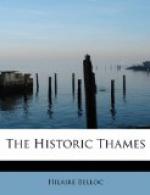The estuary has, of course, always formed a division, and in the barbarian period it separated the higher civilisation of Kent from that of the East Saxons, who were possibly of a different race, and certainly of a different culture. But the Thames above London Bridge was not a true boundary until the civilisation of England began to form, towards the close of the Dark Ages. It is perpetually crossed and recrossed by contending armies, and the first result of a success is to cause the conqueror to annex a belt from the farther bank to his own territories.
It is further remarkable that the one great definite boundary of the Dark Ages in England—that which was established for a few years by Alfred between his kingdom and the territory of the Danish invaders—abandons the Thames above bridges altogether, and uses it as a limitation in its estuarial part only, up to the mouth of the Lea.
With the definition of exact frontiers for the English counties, however, a process whose origin can hardly antedate the Norman Conquest by many years, the Thames at once becomes of the utmost importance as a boundary.
Its higher and hardly navigable streams are not so used. The upper Thames and its little tributaries for some ten miles from its source are not only indifferent to county boundaries, but run through a territory which has been singularly indefinite in the past. For instance, the parish of Kemble, wherein the first waters now appear, has been counted now in Gloucester, now in Wilts. But when these ten miles are run, just after Castle Eaton Bridge, and not quite half way between that bridge and the old royal palace at Kempsford, the Thames becomes the line of division between two counties, and from there to the sea it never loses its character of a boundary.
It is a tribute to the great place of the river in history that there is no other watercourse in England nor any other natural division of which this is so universally true.
The reason that the Thames, like so many other European boundaries, has come late into the process of demarcation, and the reason that its use as a limit is more apparent in civilised than in uncivilised times, is simply the fact that limits and boundaries themselves are never of great exactitude save in times of comparatively high civilisation. It is when a complex system of law and a far-reaching power of execution are present in a country that the necessity for precise delimitation arises. In the barbaric period of England there was no such necessity. Doubtless the men of Berkshire and the men of Oxfordshire felt themselves to be in general divided by the stream; but had we documents to hand (which, of course, we have not) it might be possible to show that exceptional tracts, such as the isolated Hill of Witham (which is much more influenced by Oxford than by Abingdon), was treated as the land of Oxfordshire men in early times, or was perhaps a territory in dispute; and something of the same sort may have existed in the connection of Caversham with Reading.




